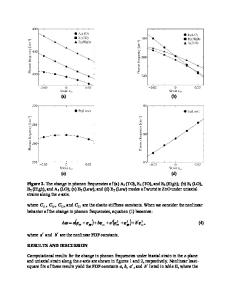Interaction of Pyrene Ligands with Neat and Defective Two Dimensional ZnO: A First Principles Study
- PDF / 324,679 Bytes
- 7 Pages / 432 x 648 pts Page_size
- 21 Downloads / 288 Views
Interaction of Pyrene Ligands with Neat and Defective Two Dimensional ZnO: A First Principles Study Velappa Jayaraman Surya*,1,2, Yuvaraj Sivalingam1,2, Velappa Jayaraman Sowmya3, Palani Elumalai4, Gabriele Magna3, Roberto Paolesse5, Corrado Di Natale3, and Yoshiyuki Kawazoe6 1
Department of Physics and Nanotechnology SRM University, Kattankulathur, Kanchipuram DT, Tamil Nadu, India- 603203 2 SRM Research Institute SRM University, Kattankulathur, Kanchipuram DT, Tamil Nadu, India- 603203 3 Department of Electronic Engineering University of Rome Tor Vergata, Via del Politechnico 1, 00133 Roma, Italy 4 Department of Chemistry University at Qatar, Doha 23874, Qatar 5 Department of Chemical Science and Technology University of Rome Tor Vergata, Via del Politechnico 1, 00133 Roma, Italy 6 New Industry Creation Hatchery Center 6-6-4 Aoba, Aramaki, Tohoku University, Sendai 980-8579, Japan *
Corresponding author E-mail: [email protected]
ABSTRACT Many heterogeneous and flat two dimensional (2D) materials with finite band gap have been researched for its suitability in exotic applications. For instance, zinc oxide (ZnO) with honey comb structure has optimum band gap that makes it eligible for opto-electronic applications. Recently, our research group have found that pyrene based tetratopic ligands (PTL) are suitable for functionalizing ZnO nanorods. In this study, neat and defective 2D ZnO layer is functionalized with different pyrene based ligands with various functional groups. First principles calculations are done and the degree of affinity of pyrene ligands towards neat and defective ZnO sheets is compared. INTRODUCTION Ever since the discovery of graphene [1,2], scientific communities are in search of other two dimensional (2D) materials which possess unique properties. Due to its semimetallic nature, graphene cannot be accommodated in the list of efficient materials for manufacturing switching based electronic devices. In this regard, many heterogeneous and flat 2D materials with finite
2799 Downloaded from https://www.cambridge.org/core. Monash University, on 07 Nov 2017 at 12:00:13, subject to the Cambridge Core terms of use, available at https://www.cambridge.org/core/terms. https://doi.org/10.1557/adv.2017.548
band gap have been found which includes carbides, nitrides, and oxides sheets of various elements in the periodic table [3].
Figure 1. Optimized structures of neat ZnO and defective ZnO with divacancy (greyish blue and red sticks represent Zn and O atoms). Zinc oxide (ZnO) is considered as a potential candidate for opto-electronic applications, widely. Experimentalists of our research group have been using ZnO nanomaterials functionalized with organic molecules like porphyrins for chemical sensing applications [4-8]. The hybrid nanomaterials composed of ZnO nanorods and porphyrins are very efficient for sensing volatile organic compound (VOCs) like alcohols, amines, and hydrocarbons like hexane [4-8]. Very recently, we have used pyrene based tetratopic ligands (PTL) for functionalizing ZnO na
Data Loading...










